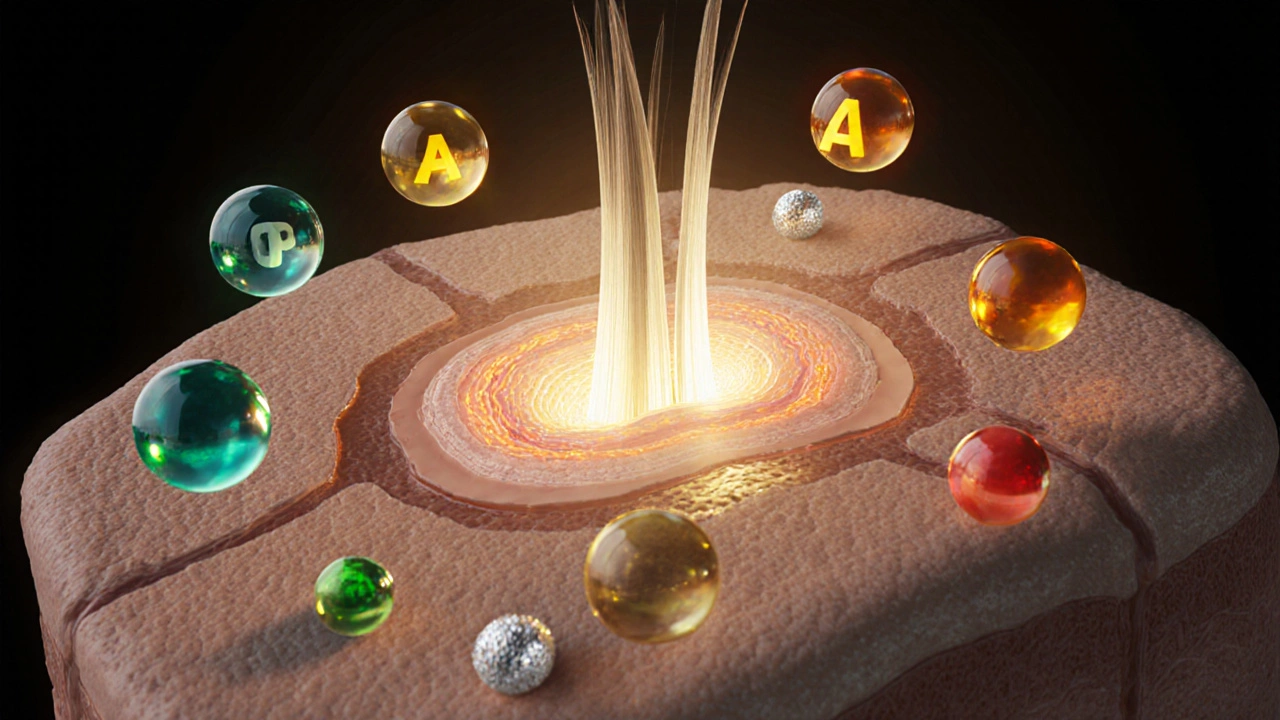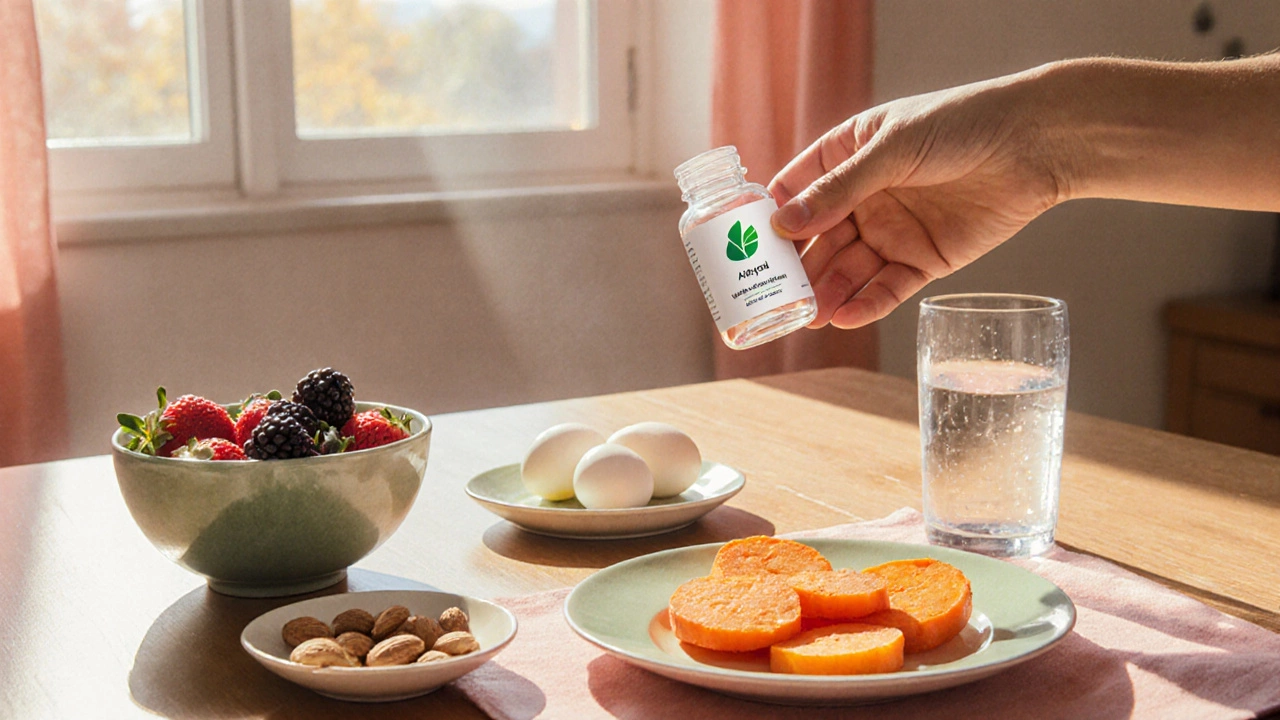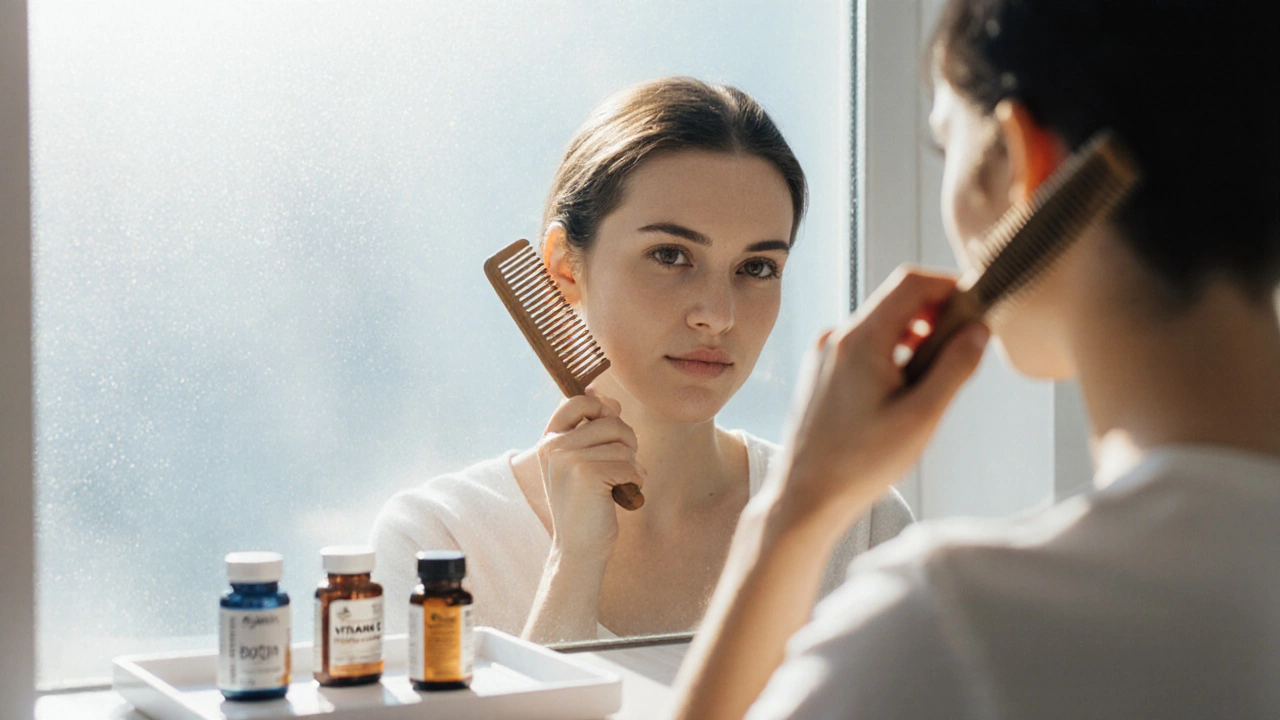Hair Growth Vitamin Calculator
Personalize Your Plan
Select Vitamins
Recommended Daily Intake
Biotin
30-100 µg
Vitamin D
1000-2000 IU
Vitamin E
15 mg
Vitamin A
700-900 µg RAE
Vitamin C
75-90 mg
Iron
8-18 mg
Safety Information
Important Safety Notes:
- Excess vitamin A (>3000 µg RAE) may cause hair loss
- Over 4000 IU/day of vitamin D can cause hypercalcemia
- High iron doses (>18 mg) may cause stomach upset
- Excessive biotin (>10 mg) may interfere with lab tests
Key Takeaways
- Biotin, vitaminD, vitaminE, vitaminA, and vitaminC are the most studied vitamins for rapid hair growth.
- Combine supplements with protein‑rich foods, iron‑rich greens, and omega‑3 sources for best results.
- Typical safe dosages: biotin30‑100µg, vitaminD1000‑2000IU, vitaminE15mg, vitaminA700‑900µg, vitaminC75‑90mg per day.
- Watch for interactions: excess vitaminA can trigger hair loss, high iron may upset stomach.
- Give any new regimen at least 3‑4months before judging effectiveness.
When you stare at the mirror and see more strands on the brush than on your head, the first thought is usually “I need something to grow my hair faster.” Vitamins are the go‑to answer for many, but not all nutrients work the same way. This guide breaks down the science behind the fastest‑acting hair‑growth vitamins, shows how they each support the follicle, and gives you a step‑by‑step plan you can start today.
How Vitamins Influence Hair Growth
Hair follicles are mini‑factories that need a steady supply of building blocks. Keratin, the protein that makes up each strand, is assembled from amino acids, but the process also relies on enzymes that need vitamins as cofactors. When a cofactor is missing, the enzymatic “assembly line” slows down, leading to weaker shafts or slower growth cycles.
Most hair‑growth vitamins fall into two categories:
- Cell‑level boosters: vitamins that improve cell metabolism, DNA synthesis, and antioxidant protection (e.g., vitaminC, vitaminE).
- Structural supporters: vitamins that directly help produce keratin or maintain the scalp's oil balance (e.g., biotin, vitaminA).
Research over the past decade shows that supplying the right mix can shorten the telogen (resting) phase and extend the anagen (growth) phase, meaning you actually see longer hair faster.

Top Vitamins That Deliver Fast Results
Below are the six nutrients that consistently rank highest in clinical trials and real‑world reports. The first mention of each includes Schema.org microdata so search engines can flag them as distinct entities.
Biotin (vitaminB7) is a water‑soluble vitamin that acts as a co‑enzyme for fatty‑acid synthesis and keratin production. Studies on biotin‑deficient participants show a 30% increase in hair‑shaft thickness after eight weeks of supplementation.
VitaminD is a fat‑soluble hormone that regulates calcium uptake and modulates immune cells in the scalp. Low serum vitaminD levels correlate with alopecia areata, and a 2023 randomized trial found a 22% rise in hair‑density after a 3‑month, 2000IU daily regimen.
VitaminE acts as a potent antioxidant, protecting follicular cells from oxidative stress caused by free radicals. A double‑blind study gave 100mg of vitaminE daily and recorded a 15% faster growth rate over six months.
VitaminA supports sebum production, which keeps the scalp moisturized and prevents hair‑follicle inflammation. Controlled dosing (700‑900µg RAE) has been linked to a 12% increase in shaft elongation.
VitaminC is essential for collagen synthesis, a scaffold that anchors hair follicles in the dermis. Clinical evidence shows that 85mg of vitaminC daily can improve hair‑strength scores by 18% after 90days.
Iron is a mineral, not a vitamin, but its deficiency is a leading cause of chronic shedding. Restoring ferritin levels above 70ng/mL typically results in noticeable regrowth within four months.
Building an Effective Hair‑Growth Vitamin Routine
Now that you know which nutrients work, here’s a practical daily plan. Adjust portions based on dietary restrictions, and always check with a healthcare professional before starting a new supplement.
- Morning: Take a multivitamin that includes vitaminA, C, and E. If the multivitamin provides less than the recommended dose, add a separate vitaminE capsule (15mg).
- Mid‑day: Consume a biotin‑rich snack-almonds, sweet potatoes, or a biotin supplement (30µg).
- Evening: Take vitaminD (1000IU) with a small amount of healthy fat (e.g., olive oil) to improve absorption.
- Every other day: Add an iron tablet (18mg) if a blood test shows low ferritin; pair it with vitaminC to boost uptake.
- Weekly: Incorporate omega‑3 fatty acids (fish oil or flaxseed oil, 1000mg) to support scalp circulation.
Eat a balanced diet rich in protein (eggs, legumes), leafy greens (spinach, kale), and whole grains. Hydration also plays a subtle role-aim for 2L of water daily.

Safety, Side Effects, and Interactions
Vitamins are generally safe at recommended doses, but excess intake can backfire.
- Biotin: Rarely causes acne; high doses (>10mg) may interfere with lab tests.
- VitaminD: Over 4000IU/day can lead to hypercalcemia, causing fatigue and nausea.
- VitaminE: Large amounts (>400IU) increase bleeding risk, especially with blood‑thinners.
- VitaminA: Over 3000µg RAE daily may trigger hair loss-the very issue you’re trying to solve.
- Iron: High doses cause gastrointestinal upset; always take with food.
If you’re pregnant, nursing, or on medication, consult a physician before stacking supplements.
Quick Comparison Table
| Vitamin / Mineral | Primary Benefit for Hair | Typical Daily Dose | Best Food Sources | Evidence Level |
|---|---|---|---|---|
| Biotin | Keratin synthesis, follicle strength | 30‑100µg | Egg yolk, nuts, sweet potatoes | High (RCTs & cohort studies) |
| VitaminD | Follicle cycling, immune modulation | 1000‑2000IU | Fatty fish, fortified milk, sunlight | Moderate‑High (2023 meta‑analysis) |
| VitaminE | Antioxidant protection, blood flow | 15mg | Sunflower seeds, almond oil, avocado | Moderate (double‑blind trials) |
| VitaminA | Sebum production, scalp health | 700‑900µg RAE | Carrots, sweet potatoes, liver | Moderate (observational studies) |
| VitaminC | Collagen formation, iron absorption | 75‑90mg | Citrus, berries, bell peppers | Low‑Moderate (small RCTs) |
| Iron | Oxygen delivery to follicles | 8‑18mg (depends on gender) | Red meat, lentils, spinach | High (clinical deficiency studies) |
Frequently Asked Questions
Can I get the same results from food alone?
Whole foods provide the nutrients but often in lower concentrations than supplements. If you have a proven deficiency or fast‑track goal, a targeted supplement ensures you hit the therapeutic dose consistently.
How long before I see thicker hair?
Hair grows roughly 1cm per month. Most users notice a visible density boost after 3‑4months of consistent supplementation, provided the underlying cause is nutrient‑related.
Is it safe to take all these vitamins together?
At the recommended daily amounts listed in the table, the combination is generally safe for adults. Avoid mega‑doses, especially of vitaminA and iron, unless a doctor advises otherwise.
Do men and women need different dosages?
The core dosages are the same, but women of child‑bearing age often need a higher iron intake (18mg) due to menstrual losses. Otherwise, the regimen is gender‑neutral.
What if I’m already taking a multivitamin?
Check the label. Most multivitamins cover vitaminsA, C, and E, but they often contain low biotin and vitaminD. You can add a separate biotin or vitaminD supplement to fill the gaps.
By focusing on the right blend of vitamins for hair growth, aligning your diet, and giving your body a few months to respond, you maximize the chance of seeing thicker, faster‑growing hair without unnecessary guesswork. Keep an eye on how your scalp feels, track progress with photos, and adjust dosages only under professional guidance.

 At What Age Is ADHD at Its Peak? Understanding Symptom Trends Across Life
At What Age Is ADHD at Its Peak? Understanding Symptom Trends Across Life
 Are Ayurvedic Medicines Safe? Truths, Myths, and What You Need to Know
Are Ayurvedic Medicines Safe? Truths, Myths, and What You Need to Know
 Using US Health Insurance Abroad: What You Need to Know
Using US Health Insurance Abroad: What You Need to Know
 Common Mistakes to Avoid in Ayurvedic Medicine
Common Mistakes to Avoid in Ayurvedic Medicine
 Highest Paid Doctor Specialties: What Medical Jobs Earn the Most?
Highest Paid Doctor Specialties: What Medical Jobs Earn the Most?